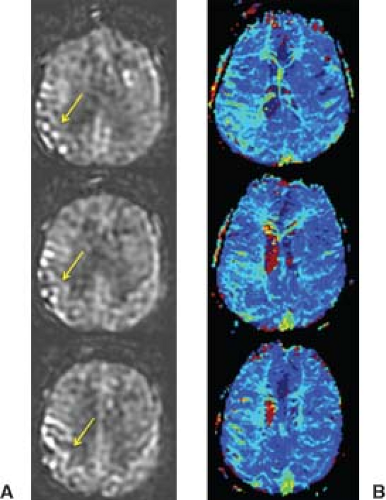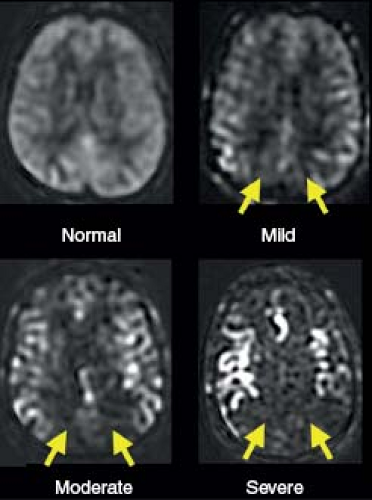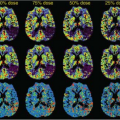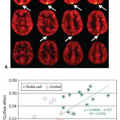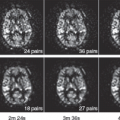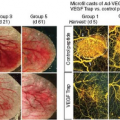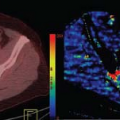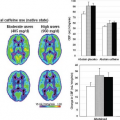Perfusion Imaging in Chronic Occlusive Disease of Intracranial Vessels and Vascular Reserve Testing
Jeroen Hendrikse
Greg Zaharchuk
Chronic occlusive disease of cerebrovasculature is present when a patient has occlusion or hemodynamically significant stenosis of the major arterial vessels leading from the heart to the brain. These include both extracranial (common and internal carotid arteries [ICA], vertebral arteries) and intracranial arteries (vertebral, basilar, intracranial ICA; middle, anterior, and posterior cerebral arteries). The most common cause of chronic occlusive cerebrovascular disease is atherosclerotic disease, which can be accelerated by patient factors such as diabetes mellitus, hyperlipidemia, and smoking. Furthermore, it is more common in patients of Chinese descent, suggesting that it can be the most common cause of stroke worldwide.1 Another large group of patients affected are those with moyamoya disease,2 a vasculopathy of unknown cause that affects primarily children and young adults and preferentially targets the intracranial circulation, particularly the region surrounding the ICA terminus.
Chronic occlusive diseases are typically diagnosed due to sequelae of hypoperfusion, particularly small embolic strokes, transient ischemic attack, and headache. Hemorrhage can also be a presenting symptom in patients with moyamoya disease, thought to occur due to the fragile and imperfect collateral vessels that form in this disease. Increasing use of imaging has led to increasing identification of these disease entities. Once vascular stenoses or occlusions are implicated, discussion shifts to treatment strategies, including both medical and surgical approaches. Medical approaches revolve around secondary stroke prevention and include statins and anticoagulation. For acute presentations, permissive or induced hypertension can improve clinical symptoms. Surgical options include endarterectomy for extracranial (particularly carotid) lesions, angioplasty, and surgical bypass. For occlusive disease, particularly moyamoya disease and carotid occlusion, extracranial-to-intracranial (EC-IC) bypass is the only surgical option but has not been shown beneficial in randomized clinical ICA occlusion trials.3,4,5
To try to better understand the individual risk of patients with chronic occlusive disease, clinicians often employ some means of vascular reserve testing, essentially a “stress test” for the cerebrovasculature. Typically, manipulations are employed that increase the carbon dioxide concentration in the blood, because this is a strong stimulator of increased cerebral blood flow (CBF). This can be achieved with pharmacologic means (acetazolamide [Diamox]), breath-hold, or direct carbon dioxide inhalation through a facemask. Typically, normal individuals can increase their CBF globally by about 30% to 50%6; lower values or even paradoxical CBF decreases, known as the steal phenomenon, are seen in patients with impaired reserve. It has been hypothesized that patients with poor reserve are at higher risk of subsequent cerebrovascular events7,8,9 and therefore would benefit from more aggressive therapies. Nevertheless, this has not been confirmed by all studies.10,11
This chapter will focus on intracranial stenosis and occlusion and thus cover both atherosclerotic disease and moyamoya disease. It will review the clinical characteristics, appearance on conventional imaging, and typical perfusion patterns. Chapter 49 will address extracranial occlusive disease and thus focus on carotid stenosis and relevant trials.
Intracranial Atherosclerotic Disease
Clinical Characteristics
Intracranial atherosclerotic disease (ICAD) is defined as stenosis or occlusion of the intracranial ICA, middle cerebral artery (MCA) M1 and M2 segments, or the vertebrobasilar system. As such, hypoperfusion and strokes in these regions tend to come to clinical attention earlier than those in other intracranial vessels. ICA lesions classically present with amaurosis fugax, or the shade-like obscuration of vision in a single eye, but can also present with motor weakness when lesions occur in the vascular watershed regions. MCA lesions are more commonly associated with motor weakness and speech changes. So-called limb shaking episodes can be seen in patients with severe hemodynamic compromise. Vertebrobasilar lesions often manifest with lightheadedness, syncope, and autonomic nervous system changes. Atherosclerotic vascular disease is usually seen in a more elderly population but can be present in younger patients with predispositions, such as hyperlipidemia, smoking, and diabetes mellitus.
Appearance on Conventional Imaging
The gold standard for the diagnosis of ICAD is digital subtraction angiography (Fig. 48.1). However, several
characteristic findings on conventional tomographic imaging can suggest the diagnosis. Low attenuation lesions on computed tomography (CT) or high signal intensity on fluid-attenuated inversion recovery or diffusion-weighted imaging magnetic resonance imaging (MRI) in the watershed regions or in the posterior fossa can often be a clue to this diagnosis. Even without the use of angiographic sequences, absent vascular flow voids on MRI (particularly well seen on T2-weighted spin-echo sequences), can suggest this diagnosis. Finally, CT and MR angiography (MRA) also depict the vascular lesions of ICAD. Prior studies suggest that CT angiogram has a higher concordance with digital subtraction angiography than does MRA.12,13
characteristic findings on conventional tomographic imaging can suggest the diagnosis. Low attenuation lesions on computed tomography (CT) or high signal intensity on fluid-attenuated inversion recovery or diffusion-weighted imaging magnetic resonance imaging (MRI) in the watershed regions or in the posterior fossa can often be a clue to this diagnosis. Even without the use of angiographic sequences, absent vascular flow voids on MRI (particularly well seen on T2-weighted spin-echo sequences), can suggest this diagnosis. Finally, CT and MR angiography (MRA) also depict the vascular lesions of ICAD. Prior studies suggest that CT angiogram has a higher concordance with digital subtraction angiography than does MRA.12,13
Typical Perfusion Patterns
The typical perfusion pattern in patients with atherosclerotic cerebrovascular disease of the intracranial vessels is variable. Mild to moderate disease may only be visible on high-resolution angiographic images, with regions of stenosis and irregularity. In more severe cases, perfusion abnormalities within the affected vascular territory can be seen on dynamic susceptibility contrast (DSC) or arterial spin label (ASL) imaging. on DSC, typically the most sensitive indication of intracranial disease is delayed contrast arrival, either in the vascular border zones or a specific vascular territory (Fig. 48.2). Both arterial input function (AIF)-corrected (time to the maximum of the residue function [Tmax]) or uncorrected (time-to-peak [TTP] maps) can be used for this purpose. If the stenosis or occlusion is particularly hemodynamically significant, increases in other parameters, such as the relative cerebral blood volume (rCBV) or mean transit time (MTT), can be present, although in the authors’ experience, this is less common. Kim et al.14 demonstrated that relative MTT lesions (normalized by the contralateral hemisphere) showed abnormalities in patients with symptomatic MCA stenosis. Finally, most patients do not have significant CBF changes without evidence of ischemic stroke, suggesting that they have not exceeded the limits of autoregulation.
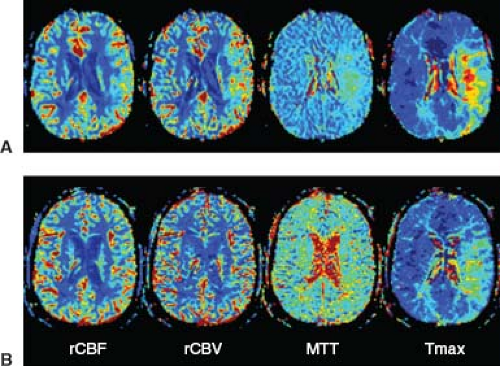 FIGURE 48.2. Bolus contrast dynamic susceptibility contrast perfusion-weighted imaging (in the same patient as Figure 48.1). Images of relative cerebral blood flow (rCBF), relative cerebral blood volume (rCBV), mean transit time (MTT), and time to the maximum of the residue function (Tmax) are shown (A) when the patient’s systolic blood pressure was 160 mm Hg and symptoms of ischemia were present. (B) The same maps after hypertensive therapy, when the patient’s systolic blood pressure was 200 mm Hg with resolution of symptoms. Some differences between the images are evident, as the initial study was performed at 3T, while the follow-up study was performed at 1.5T. Nevertheless, there is the suggestion that the Tmax in the left middle cerebral artery territory is shorter and that the asymmetry in MTT is no longer present. |
Standard bolus DSC is challenging in these patients for several reasons. The first is the question of where to choose the AIF. This was addressed by Mukherjee et al.15 in patients with unilateral carotid occlusion. They showed that in six of seven patients, it had no effect on the accuracy of the CBF measurements when compared with positron emission tomography. Nevertheless, very little information on the effects of AIF placement exists for
patients with intracranial stenosis or occlusion. Calamante et al.16 discussed many of these issues for patients with moyamoya disease, who may have bilateral occlusion of the MCA and anterior cerebral arteries (ACAs) with extensive collaterals. Although bolus DSC is usually performed with echo-planar imaging, which typically shows distortion at the lower slices, the authors recommend using the basilar artery in ICAD patients (assuming the disease is affecting the anterior circulation). An example of bolus DSC studies in a patient with symptomatic unilateral MCA occlusion is shown in Figure 48.2, demonstrating that there was a reduction in Tmax and possible normalization of MTT within the MCA territory following hypertensive therapy.
patients with intracranial stenosis or occlusion. Calamante et al.16 discussed many of these issues for patients with moyamoya disease, who may have bilateral occlusion of the MCA and anterior cerebral arteries (ACAs) with extensive collaterals. Although bolus DSC is usually performed with echo-planar imaging, which typically shows distortion at the lower slices, the authors recommend using the basilar artery in ICAD patients (assuming the disease is affecting the anterior circulation). An example of bolus DSC studies in a patient with symptomatic unilateral MCA occlusion is shown in Figure 48.2, demonstrating that there was a reduction in Tmax and possible normalization of MTT within the MCA territory following hypertensive therapy.
ASL imaging is particularly sensitive to mild delays in arterial transit times, which is a disadvantage for measuring quantitative CBF. Nevertheless, this sensitivity, which arises because of the dependence of the label on the T1 of the blood (1.2 to 1.6 seconds at typical field strengths), can be useful for identifying a region with a mild transit delay (Fig. 48.3). The extreme case of this is likely the so-called border-zone sign,17 which represents severe transit delay so that the ASL signal is only present in the feeding arteries and has yet to enter the (capillary network of the) tissue at the time of imaging (Fig. 48.4). It should be noted that the precise etiology of the border-zone sign is unclear, and transit delays can occur due to poor cardiac output or small vessel ischemic disease in addition to stenosis of large and medium-sized intracranial arteries that is depicted on angiographic sequences.
Moyamoya Disease
Clinical Characteristics
Moyamoya disease is named after the Japanese term for “puff of smoke.” This is because of the difficulty in spatially resolving the multiple tiny collateral vessels that occur at the base of the brain, in an attempt to revascularize stenosis and occlusion of the region of the internal carotid artery terminus and proximal M1 and A1 segments. The cause of moyamoya disease is still currently unknown, although there is some evidence for a small genetic component. Most cases occur either in the pediatric population or in young adults. Although the disease was first identified in the Japanese and is thought to be more common in Asians, it affects all ethnic groups. Furthermore, with the more widespread availability of noninvasive imaging with MRI and CT angiography, it is being identified more frequently. Most patients present with transient ischemic attacks or small strokes, typically in border-zone regions. Less commonly, but still well recognized, is its presentation with hemorrhage, and moyamoya disease factors high in the considerations that must be made when confronted with a young patient with intracranial hemorrhage. Less common presentations include headaches, seizures, and developmental delay.
Appearance on Conventional Imaging
Moyamoya disease can be assessed using conventional MRI, where the absence of T2 flow voids and small
serpiginous collaterals at the base of the brain are frequently seen. Another typical finding is the “ivy sign,” defined as high signal on fluid-attenuated inversion recovery imaging in the supratentorial sulci, and representative of slow flow in large pial leptomeningeal collaterals. MRA is also characteristic, with the mildest cases showing stenosis of the ICA terminus region and more severe cases demonstrating occlusion of the proximal segments of the MCA and ACA. Rarely, diffusion abnormalities in the watershed regions can be seen and, if present in a young patient, should raise suspicion for moyamoya disease.
serpiginous collaterals at the base of the brain are frequently seen. Another typical finding is the “ivy sign,” defined as high signal on fluid-attenuated inversion recovery imaging in the supratentorial sulci, and representative of slow flow in large pial leptomeningeal collaterals. MRA is also characteristic, with the mildest cases showing stenosis of the ICA terminus region and more severe cases demonstrating occlusion of the proximal segments of the MCA and ACA. Rarely, diffusion abnormalities in the watershed regions can be seen and, if present in a young patient, should raise suspicion for moyamoya disease.
Typical Perfusion Patterns
Perfusion patterns in moyamoya are similar to those seen in atherosclerotic disease, with the exception that abnormalities are frequently bilateral and affect primarily the anterior circulation. The most common findings on DSC are prolonged contrast arrival times,16,18 particularly if delay-insensitive circular deconvolution is used.19 If severe, changes in MTT that represent an increased ratio of CBV to CBF can also be seen. An example of this in a patient with bilateral moyamoya is shown as Figure 48.5.
ASL imaging has been applied to moyamoya as well.20,21,22,23 One important caveat is that delay times are quite long in moyamoya, and underestimation of CBF or artifacts related to slow flow will be seen if ASL sequences with typically used inflow times (1 to 2 seconds) are used (Fig. 48.5).20 One recent study has shown that the use of longer inflow times (i.e., longer postlabel delays [PLD]) for pseudo-continuous ASL) demonstrates an increase in the apparent CBF at longer PLD in moyamoya patients.21 In fact, it can be that conventional ASL at long PLD overestimates CBF because the label spends more time in the blood rather than in the tissue, where T1 is longer, and therefore experiences less decay than expected. ASL approaches that use multiple time points to simultaneously acquire CBF and arrival time can be useful in this population, although it is important to remember that very long inflow times must be acquired.24,25 Finally, velocity-selective ASL,26 in which the label is applied not spatially in the neck but rather within the voxel itself based on blood velocity, can be particularly efficacious for both ICAD and moyamoya disease (Fig. 48.6). In a study of patients with long arterial arrival times, velocity-selective ASL had the best performance overall compared with gold standard xenon CT CBF, and in particular, the errors had the least dependence on arrival time.21
Stay updated, free articles. Join our Telegram channel

Full access? Get Clinical Tree



